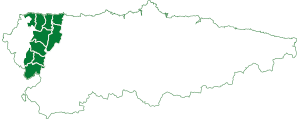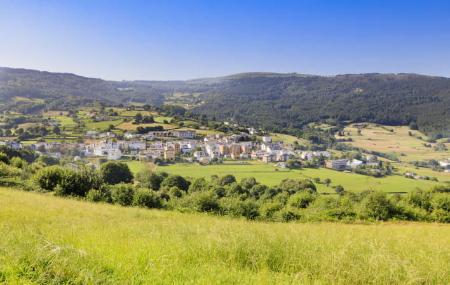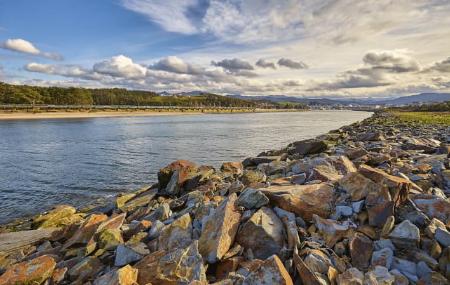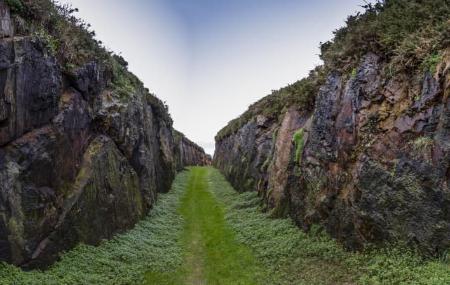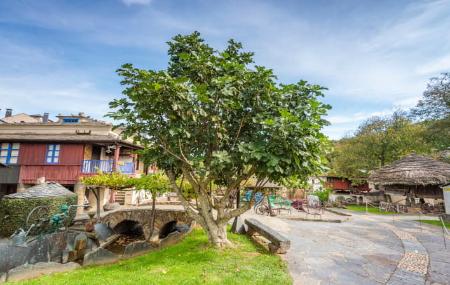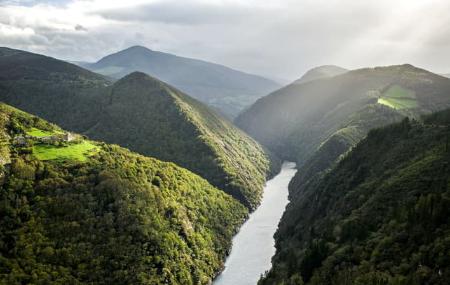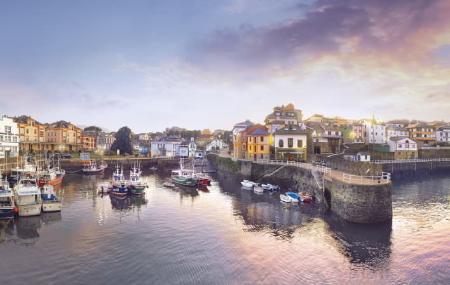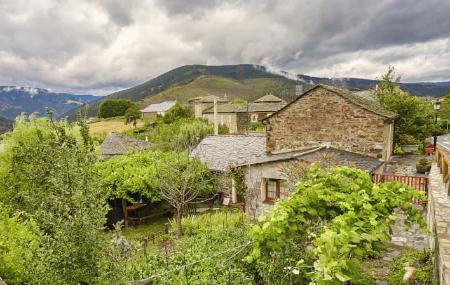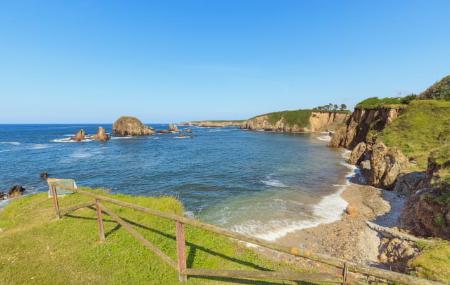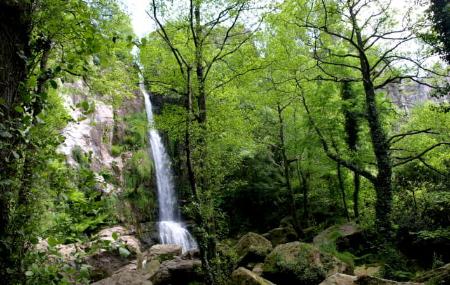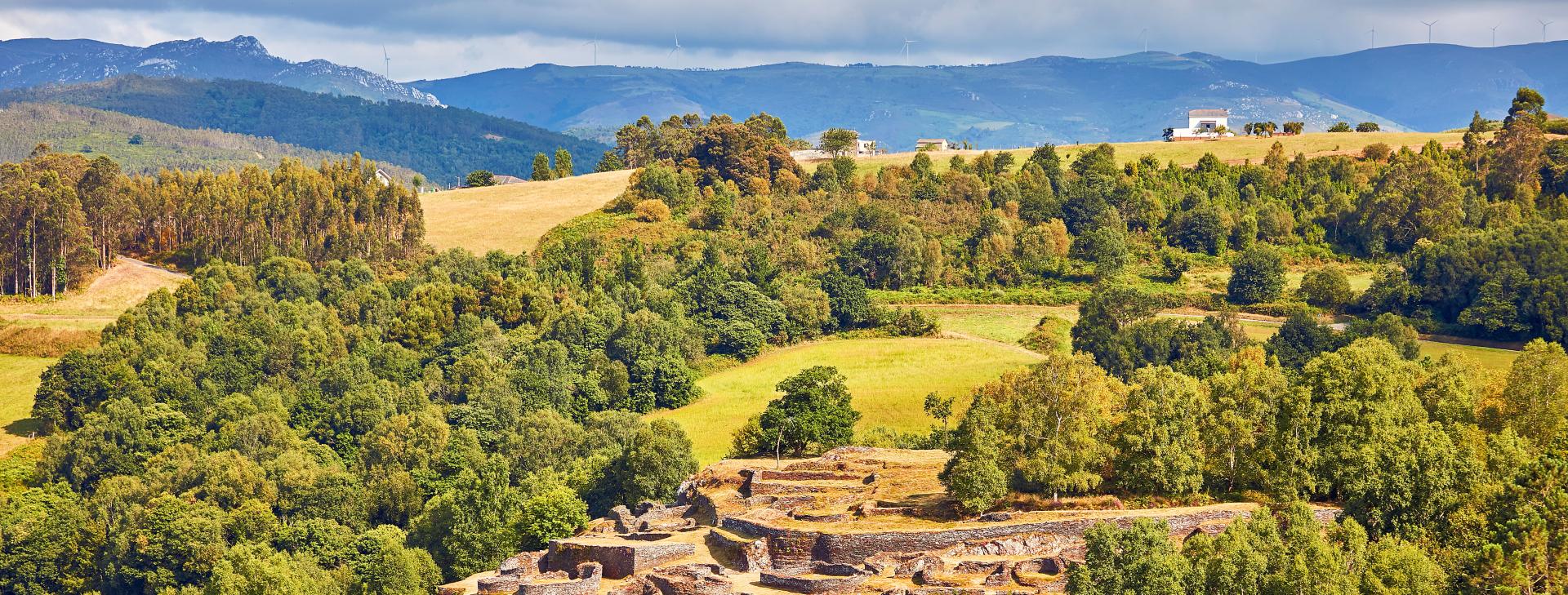
Navia Historical Park
Everything in this region begins and ends with water. It moves mills, leaps in waterfalls, widens in reservoirs and flows into the sea in the Navia estuary. Along the way, it shapes the landscape, makes the land more fertile, activates the trades, structures the roads and gives meaning to a resilient and wise way of life. From this intimate relationship with water also comes the name of Navia: a pre-Roman word, the name of a goddess protector of valleys and rivers, which today designates a land of dolmens and forts, palaces and mansions, beaches and maritime ports.
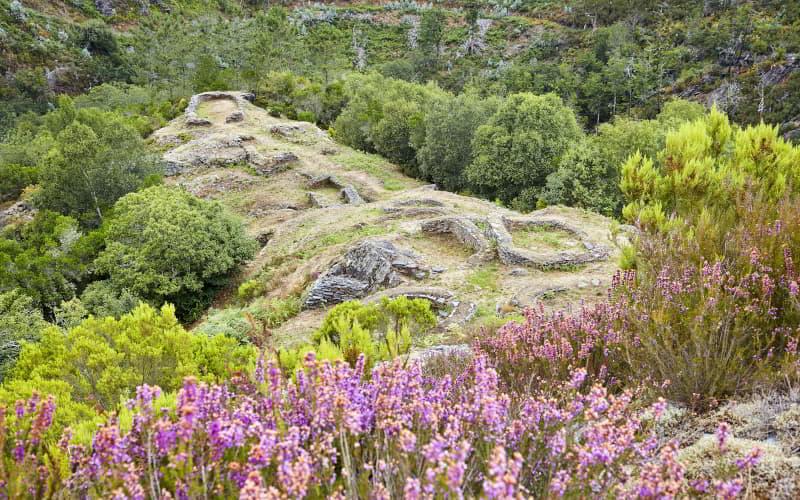
History and heritage of the Navia Historical Park
Although the first human traces in the region date back millennia, as evidenced by the dolmen of Entrerríos (one of the greats of Asturian megalithism) or the unique cave paintings of the Cova del Demo, from the Bronze Age, the greatest archaeological treasure of the area appears later, however, when the fortified villages chose the hills to build their fortified enclosures.
Castros, gold, palaces and temples
The Chao Samartín hillfort, in Grandas de Salime, is a major site in Asturias. Excavated since 1990, its archaeological wealth can be seen in the adjoining museum with more than 350 pieces on display. For its part, the castro of Coaña, no less important, was founded in the 4th century BC and shows a complex structure with walls, moats, bastions, some 80 dwellings, streets and baths. In Roman times it became very important due to its relationship with gold mining and trade from nearby deposits, such as As Covas da Andía (Natural Monument) or Salave, in Tapia de Casariego, where large gold veins were mined, collapsing mountains with the force of the water. To do this, the Romans built complex canal networks, such as the Penafurada canal, in Grandas de Salime, whose galleries and tunnels can be explored today along a beautiful path.
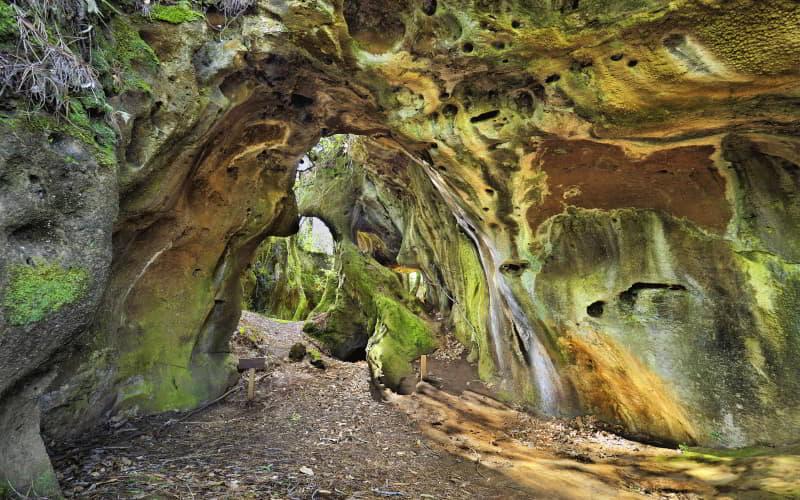
In medieval times, the region organised its defence around walled enclosures such as that of the town of Navia, of which a valuable section still remains. Navia and Puerto de Vega prospered early on thanks to trade and the passage of pilgrims along the Camino de la Costa. La Caridad/ A Caridá, capital of El Franco, was an obligatory stop before leaving Asturian lands; its toponym comes from the constant help that the neighbours gave to the pilgrims. Meanwhile, in the countryside, large palaces with the air of fortresses began to be built, such as Anleo, where, according to tradition, Saint Francis of Assisi slept in the 12th century, on his way to Santiago de Compostela. Or Tox, which is a good example of the evolution of the old defensive towers into noble residences. Over time, other palace complexes were built, such as Fronfría in El Franco; Campos in Tapia; the Palace of Ron, in the capital of the council of Pesoz, or Camposorio in Navia, the latter linked to the childhood of the poet Campoamor.
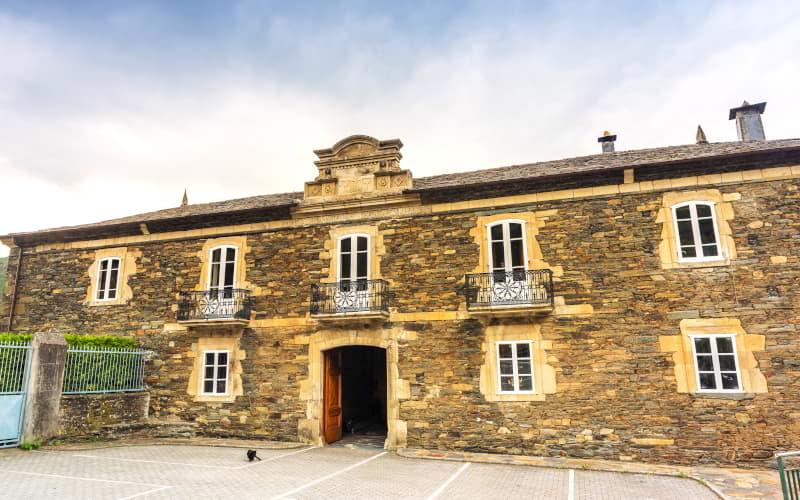
The clergy also left their mark: churches such as Santa María de Miudes, with a 13th century Romanesque apse, or the Collegiate Church of Grandas de Salime, with a Romanesque façade and magnificent 18th century altarpiece, originally built in the 12th century when the Primitive Way of St. James passed through the area. But beyond the great temples, the devotional soul also survives in places such as the Sanctuary of Pastur, in Illano, guarded by a great yew tree which is a Natural Monument. Thousands of pilgrims flock here, attracted by the miraculous fountain and the image of the virgin, which even survived a fire. No less devout is the Chapel of the Atalaya (or Telaya), built by the sailors of Puerto de Vega in 1615, to venerate a virgin who, according to legend, appeared floating in the sea after the passage of a gale.
Whales, Indianos, ethnography and reservoirs
Las Atalayas is a place name that refers to high points from which whales could be sighted. Smoke signals were used to warn the whalers, who would go out in boats to intercept them with harpoons. In Porto/Viavélez (El Franco), the days ended with the enormous cetaceans lying on the quay to begin their full exploitation. The same happened in Ortigueira, that fishing village in Coaña, which was born in the Middle Ages. At the Mirador de la Riba viewpoint, in Puerto de Vega, two colossal jaws frame the first whaling contract signed in these waters in 1608. In the same town, the Pérez Villamil Ethnographic Museum, in the old cannery of La Arenesca, has a section dedicated to this activity, with documents, photographs, models and bone remains. The name of Juan Pérez Villamil is also part of this town for other reasons. He was a committed member of the Enlightenment and one of the authors of the proclamation of the mayors of Móstoles, which ignited the resistance against Napoleon. Years later, in 1811, his friend Jovellanos died in Puerto de Vega, who, dying, was still dictating letters criticising the powerful for not defending the country against the French invasion.
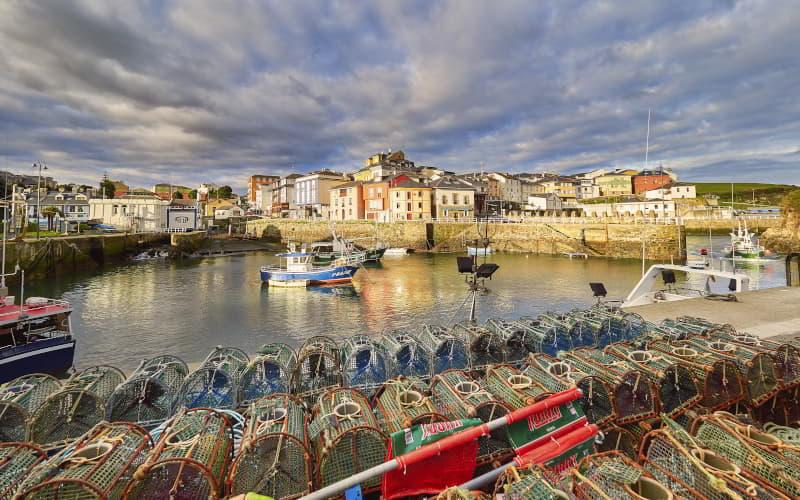
At the end of the 19th century and the beginning of the 20th, those who went to America returned with capital and a philanthropic vocation. They built elegant houses such as the Arias or Casadoiro palaces in the town of Navia, built schools in even the most remote villages, founded theatres and casinos (Puerto de Vega), and provided the territory with modern infrastructures. Boal, in particular, preserves a valuable collection of Indian architecture and celebrates every July the "Volven os americanos" festival, where locals and visitors alike turn out for a day of festivities with period costumes and classic cars.
If we talk about economy, during the 19th century the iron craft industry played a fundamental role in the area of Froseira, in Boal, where there was an important tradition of forges. This heritage is preserved and dignified in the Rozadas Iron Interpretation Centre.
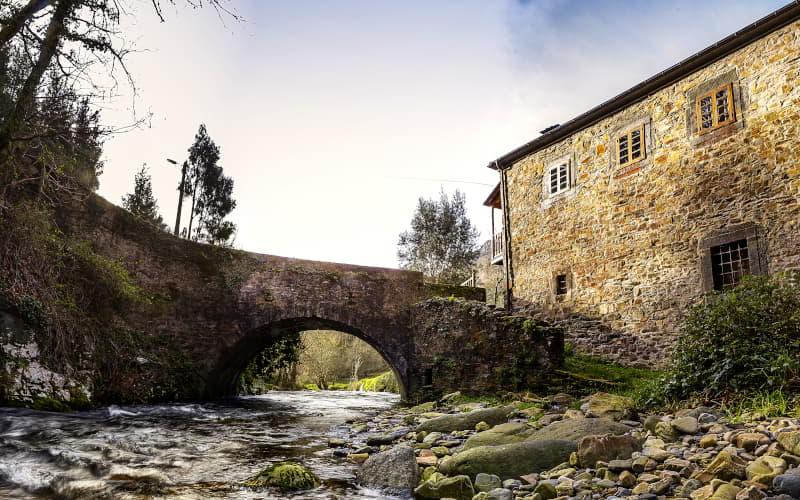
The peasant world, the basis of the territory until recently, is magnificently represented in the Ethnographic Museum of Grandas de Salime "Pepe el Ferreiro", with more than 3,000 m² dedicated to rural trades, architecture and tools.
In Boal, the Beekeeping House rescues the art of beekeeping, linked to the self-sufficiency of the Asturian farmhouse.
In the municipality of Pesoz there are two places that summarise, each in its own way, a way of inhabiting the landscape: the village of Argul and the village of A paicega. The former has medieval roots, and its stone houses are built directly into the rock, connected to each other by tunnels, passages and elevated corridors that allow you to move from one to the other without going outside. In A paicega, meanwhile, the ruins of a workers' settlement linked to the construction of the Salime reservoir are preserved, an epic that mobilised more than 3,000 workers.
In the 20th century, the Navia river basin was transformed with the construction of reservoirs, which generated an important industrial heritage. At the same time, the town of Navia became the economic capital of the region, thanks to industries such as ENCE (cellulose), Reny Picot (dairy products) and the Armón shipyards. This transformation broke with the agrarian-fishing model and laid the foundations for a new business and social fabric.
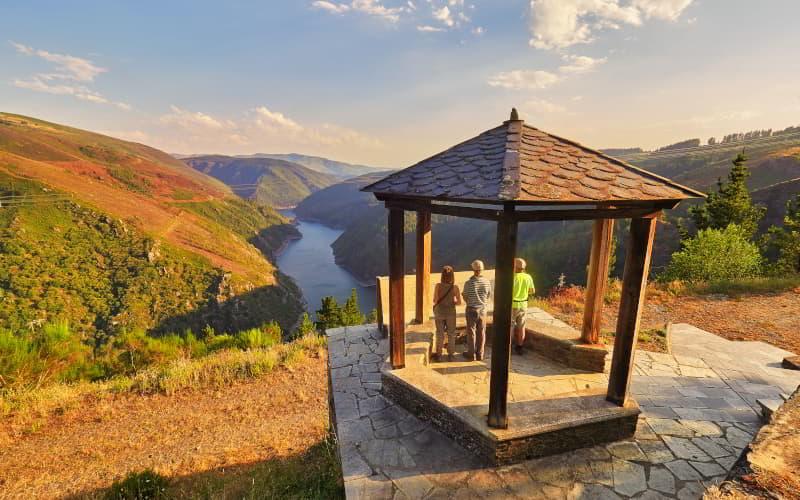
Nature and landscapes of the Navia Historical Park
Fed by good tributaries - the Ibias, the Suarna, the Ouro or the Lloredo - the river Navia ends up becoming a giant. But it slows down in those great mirrors of the western mountains that are its dammed waters. The Salime reservoir, with its titanic 128-metre high dam, is followed by the Doiras reservoir, with its 90-metre high waterfall and its vertiginous dam wedged between mountains, where the river widens and becomes navigable. In fact, the Andolina boat(opens in a new tab) takes one of the first tourist river routes in Asturias here, passing through places of great beauty, such as the Illano suspension bridge or the spectacular Santesteba cliff.
Santesteba, in the municipality of Illano, is a place well worth visiting. Hanging literally over the river Navia, it has been declared a Historic Site. Its slate and wooden houses have hardly changed since the 19th century. They are grouped together on the rock, linked by passages and structures that form a small ethnographic labyrinth.
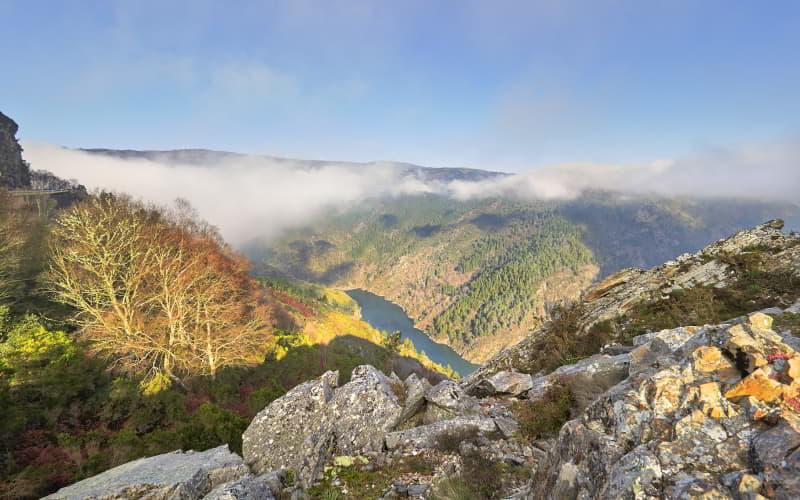
Navia viewpoints and waterfalls
We still have the Arbón reservoir, the closest to the sea and the first to be opened on the Navia for hydroelectric use. Today, this is also an ideal setting for water sports, including canoeing down the river - with a stretch of some 15 kilometres to the town of Navia.
Not far from here, in the Castriyón Bridge Recreation Area, begins a 12-kilometre circular route known as the Navia Viewpoints Route. A path that passes through villages such as El Rebollal or Silvón, where cabazos, hórreos, centenary yew trees and a rural world that does not give up survive. The route is a lesson in geography, rural history and hydroelectric engineering. And all with magnificent views of the river Navia.
Different tributaries of this river offer other river attractions, such as the Cascadas de Oneta Natural Monument, in Villayón. The route, just over two kilometres long, takes us into a shady forest where three large waterfalls await us: Firbia, Ulloa and Maiseirúa. Other waterfalls that are worth an excursion, and which are not too far from the above, are the Méxica waterfalls in Illano.
Coastal path and beaches
Once you have reached the coast, there is nothing better than to follow the Naviega Coast Path, a 20-kilometre route between cliffs, estuaries and beaches such as Barayo, which is part of the Barayo Partial Nature Reserve - a fantastic ecosystem that combines estuary, dunes, marshes and wild sandy area open to the Bay of Biscay. The path also reaches Frexulfe, a surprisingly beautiful beach with fine, toasted sand, cliffs, pine groves and well-preserved dunes. A unique environment, declared a Natural Monument and much appreciated by surfers.
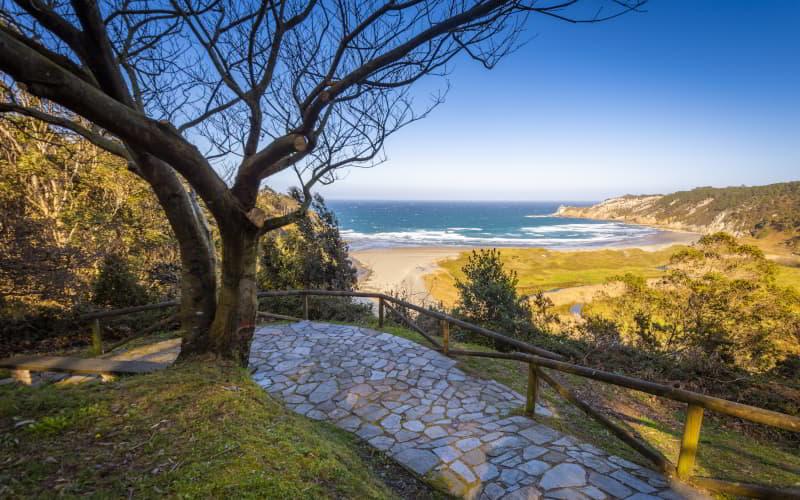
Beyond this coastal path, the region treasures no less beautiful sandy beaches. In El Franco, Porcía beach is another of the jewels of the western Asturian coast. Its waters are dotted with a small archipelago of islets that give character and personality to the landscape. Castello beach is the widest inlet in the council, with pebbles and an open horizon.
In Coaña, Arnelles beach stands out for its fine sand and rugged surroundings, near the port of Ortigueira. The beach of Torbas opens out as a wide inlet of almost a kilometre, where sand and pebbles combine with cliffs and green slopes.
In the town of Tapia, the beach of Anguileiro (or La Grande) is the main one, with about 400 metres, golden sand, with all services and very popular with surfers. It is followed in size by other small urban coves: Maleguas, As Furadas and Ribeiría. On the outskirts of the town, the beach of La Paloma / Esteiro offers tranquillity, fine sand and beautiful scenery.
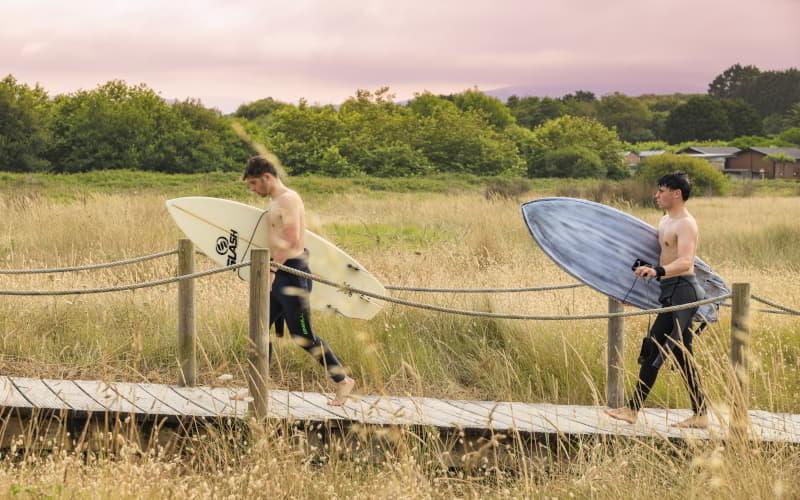
Between Tapia and Castropol, Penarronda beach is a 600-metre natural jewel in the shape of a shell and presided over by a rocky islet that gives it its name: the "round rock". It is a Natural Monument for its valuable dune ecosystem and ideal for surfing.
Guide to enjoy the region
In the Navia Historical Park, each council has its own character, its own rhythms and accents. However, there is a profound coherence between them all, the result of a shared way of inhabiting the territory that is expressed in "la fala" (officially, Eo-Naviego). The territory is well communicated and easily accessible both from the interior and from the coast. The N-634 road, which crosses the region from east to west, connects the main villages - Navia, A Caridá and Tapia - with the centre of Asturias and Galicia, while the AS-12 links the interior following the course of the river Navia as far as Grandas de Salime. The Autovía del Cantábrico (A-8), allows you to get there from Oviedo/Uviéu or Gijón/Xixón in just over an hour.
As for accommodation, the region offers everything from modern hotels, rural houses or charming flats, to hostels for pilgrims, campsites and well-equipped areas for motorhomes.
And finally, we look at the fishing villages of the region, from east to west, and we offer you some proposals to live and savour them. It is one of the most beautiful and elegant corners of the western coast. The Baluarte promenade, the Atalaya chapel and the old port form a harmonious ensemble that invites contemplation and strolls. The seafaring festivities of the Virgen de la Atalaya ( early September), with their celebrations: the Telayona, the Telayina and the Jira a Frexulfe, are a pagan and Marian mixture that is difficult to define but impossible to forget. Just like squid in its ink or monkfish with seafood sauce, dishes made with fresh produce that can be enjoyed in local restaurants. The ingredients come directly from one of the most beautiful and best-stocked fish markets in Asturias, the main distributor of goose barnacles in the whole region.
Navia is the most populated town in the region and a place that invites you to take a stroll, with its estuary as a natural axis and a friendly urban layout. But what really defines it is its dynamism: a town that has managed to grow without losing its roots, with a strong business fabric and a great entrepreneurial spirit. Its ancient heart beats in streets such as La Atalaya, Las Armas or San Francisco, where you can still discover emblazoned doorways and houses with glass galleries. In terms of gastronomy, it is a land of goose barnacles, fabes and cottage cheese, the famous venera cake (whose authorship is disputed with Boal) and rice pudding. The town experiences its summer apotheosis during the first week of August, when the Descenso a Nado de la Ría (Swimming Descent of the Estuary) - a Festival of National Tourist Interest - is held. This is one of the most famous long-distance swimming events in Europe.
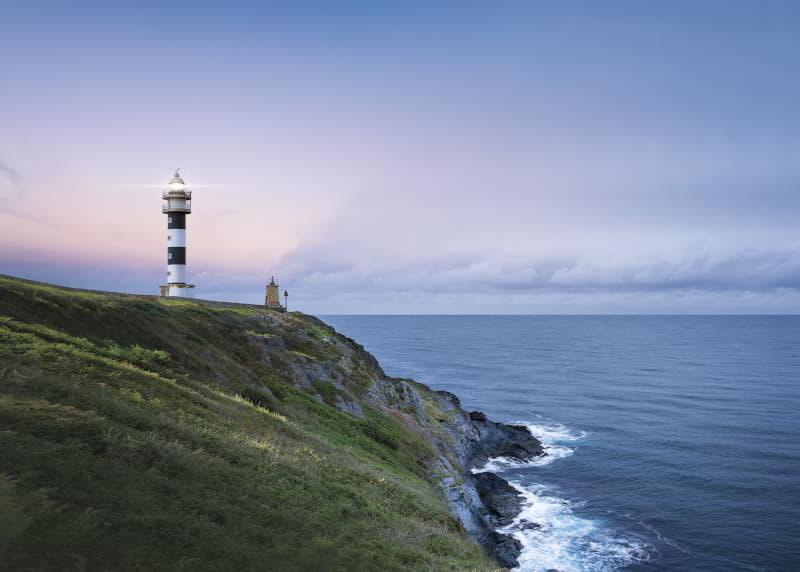
At the western end of the estuary, in the council of Coaña, Cape San Agustín is a natural viewpoint with impressive views of the Cantabrian Sea. Here you will find two lighthouses -one ancient and the other more modern-, a church on the cliff and a perfect setting for long walks by the sea. In this enclave, the capital of the council Ortigueira unfolds: a quiet and charming place that preserves a hidden and special air. It combines seafaring houses with elegant Indian constructions in its upper area.
El Porto/Viavélez (El Franco) is one of those ports that seem to be designed on an intimate scale, where everything fits together with miniaturist precision. Centuries ago, it was a whaling port and one of the most important sailing shipyards in the Bay of Biscay. Its flirtatious estuary, its houses hanging from the cliffs and its colourful boats make you fall in love at first sight. Not in vain was it the homeland of the romantic writer Corín Tellado.
The town of Tapia is one of the pioneering centres of surfing in Asturias. The "perfect" waves of its La Grande beach mean that every Easter the Goanna Pro is held here, an international surfing championship that brings together the great figures of this sport from all over the world. At the beginning of August, this town also hosts the Festival Intercéltico d'Occidente (Festival of Tourist Interest of the Principality of Asturias), with an important line-up of folk groups, bagpipe bands and other activities related to Celtic culture. From the quayside terraces, Tapia looks like a seaside postcard: the watchful lighthouse and the fleet moored on a sheltered quay. But the real spectacle is at the table: sea bass, turbot, spider crab and well-kept secrets in the kitchens.
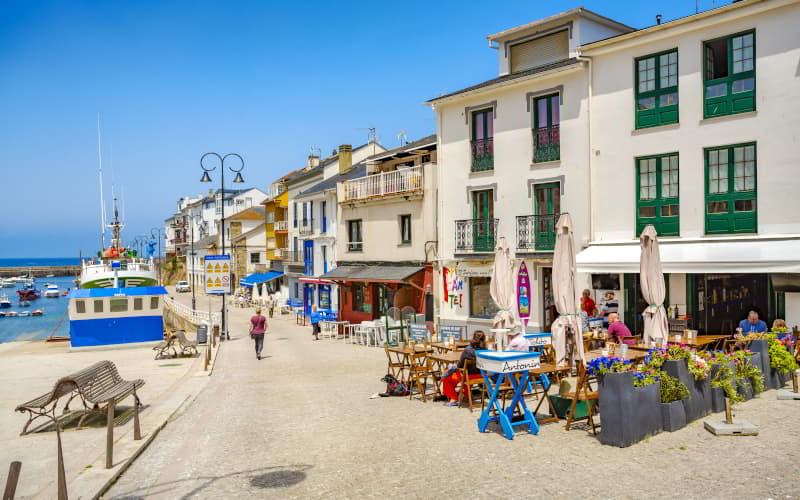
The gastronomy of the region is completed with sausages and spelt bread, with Abredo cheese from Coaña; wine, honey and bolo (similar to borona) from Pesoz; Eilao cake from Illano (sponge cake with an intense aroma of aniseed and cinnamon), or the pot from Boal.
The Navia Historical Park offers visitors authenticity. It has what many are looking for, good produce on the table, routes with history and landscapes that remain true to themselves.
Images
Map
What to see
- Fishing villages: Ortigueira, El Porto/Viavélez, Navia, Puerto de Vega, Tapia.
- Hill forts: Pendia, Coaña, Mohías, Cabo Blanco, Chao Samartín, El Castelón.
- Museums: Grandas de Salime and Pesoz.
- Singular villages: Argul, A Paicega.
- Beaches: Penarronda, Santa Gadea, Anguileiro, Frexulfe.
- Palaces: Ron Palace, Campos Palace, Anleo Palace, Fonfría Palace and Cancio Palace.

